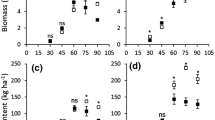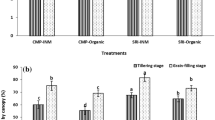Abstract
The effect of decreased nitrogen rates (90, 60 and 30 kg N/ha) with and without irrigation on celery yield quantity and internal quality were studied in field experiments in 1993 and 1994. The decreased nitrogen rates reduced yields in both years. In the dry and warm conditions of 1994 nitrogen × irrigation interaction was clearly observed; irrigation increased yield more at higher nitrogen rates than at lower nitrogen rates. In the rainy conditions of 1993 irrigation did not effect the yield level.On the other hand, in both years, decreased nitrogen rates increased dry matter, vitamin C and dietary fiber contents, and nitrogen had a minor effect on total sugar content. In 1994 alpha- and beta carotene and thiamin were also analyzed but nitrogen had no effect on them. Irrigation increased dry matter and total sugar contents at the two lowest nitrogen rates in 1994, but decreased vitamin C contents in both years. There was also slight evidence that irrigation might decrease alpha- and beta-carotene and thiamin contents.
Similar content being viewed by others
References
Balvoll G (1969) Verknad av nitrogengjødsling påkjemisk samansetnad og nærigsverde hjå grønsakvokstrar. Stensiltrykk 35: 1-9. 6 app.
Nygaard Sørensen J (1988) Afgrødekvalitet. 1. Frilandsgroensager. Statens planteavl. 1988: 7-9.
Evers AM (1989) The role of fertilization practices in the yield and quality of carrot (Daucus carotaL.). Thesis. J Agric Sci Finland 61: 323-359.
Eppendorfer WH (1978) Effects of N-fertilization on amino acid composition and nutritive value of spinach, kale, cauliflower and potatoes. J Sci Food Agric 29: 305-311.
Nilsson T (1979) Avkastning lagringsförmåga kvalitet och kemisk sammansättning hos morot vitkål och purjo vid konventionell och organisk gödsling. Institut av Trädgårds Vetenskap. Rapp. 7: 3-52.
Andersen L, Nielsen NE (1992) A new cultivation method for the production of vegetables with low content of nitrate. Scientia Hortic 49: 167-171.
Salo T (1992) Typpi-ja kloridilannoituksen vaikutus punajuurikkaan nitraattipitoisuuteen ja satoon. Maatalouden tutkimuskeskus, Tiedote 16/92, 43 pp. [The effect of nitrogen and chloride fertilization on the nitrate content and yield of beetroot. Commun Agric Res Centre of Jokioinen.].
Greenwood DJ (1986) Prediction of nitrogen fertilizer needs of arable crops. Adv Plant Nutr 2: 1-61.
Evers AM (1994) The influence of fertilization and environment on some nutritionally important quality criteria in vegetables - a review of research in the Nordic countries. Agric Sci Finland 3: 177-188.
Nygaard Sørensen J (1984) Dietary fiber and ascorbic acid in white cabbage as affected by fertilization. Acta Hortic 163: 221-230.
Nygaard Sørensen J, Mune LH (1994) Dyrkningsfaktorers indflydelse påindholdsstoffer og holdbarhed i porre. SP rapport 2: 67-74.
Leclerc J, Miller ML, Joliet E, Rocquelin G (1991) Vitamin and Mineral Contents of Carrot and Celeriac Grown under Mineral or Organic Fertilization. Biol Agric Hortic 7: 339-348.
Li B, Schuhmann P (1980) Gas-liquid chromatographic analyzis of sugars in ready-to-eat breakfast cereals. J Food Sci 45: 138-141.
Haila K, Kumpulainen J, Häkkinen U, Tahvonen R (1992) Sugar and organic acid contents of vegetables consumed in Finland during 1988-1989. J Food Compos Anal 5: 100-107.
Lee SC, Prosky L, De Vries JW (1992) Determination of Total, Soluble, and Insoluble Dietary Fiber in Foods - Enzymatic-Gravimetric Method, MESTRIS Buffer, Collaborative Study. J AOAC Int 75: 395-416.
Speek A, Schrijver J, Schreurs W (1984) Fluorometric determination of total vitamin C and total isovitamin C in foodstuffs and beverages by high-performance liquid chromatography with precolumn derivatization. J Agric Food Chem 32: 352-355.
Hägg M, Ylikoski S, Kumpulainen J (1994) Vitamin C, α-and β-carotene contents in vegetables consumed in Finland 1988-1989 and 1992-1993. J Food Compos Anal 7: 252-259.
Ollilainen VM, Heinonen M, Linkola E, Varo P, Koivistoinen P (1988) Carotenoids and retinoids in Finnish foods: Meat and meat products. J Food Compos Anal 1: 178-188.
Hägg M (1994) Effects of various commercially available enzymes in the liquid chromatographic determination with external standardization of thiamin and riboflavin in foods. J AOAC Int 77: 681-686.
Henriksen A, Selmer-Olsen AR (1970) Automatic methods for determing nitrate and nitrite in water and soil extracts. Analyst 95: 514-518.
Friendly M (1991) SAS System for Statistical Graphics. Cary, NC: SAS Institute Inc.
Chatfield C, Collins AJ (1991) Introduction to Multivariate Analysis. London: Chapman and Hall.
Tukey JW (1977) Exploratory Data Analysis. Reading, MA: Addison-Wesley.
SAS Institute Inc. (1989) SAS/STAT User's Guide, Version 6, 4th ed. Cary, NC: SAS Institute Inc.
SAS Institute Inc. (1992) SAS Technical Report P-229, SAS/STAT Software: Changes and Enhancements, Release 6.07. Cary, NC: SAS Institute Inc.
Souci SW, Fachmann W, Kraut H (1994) Food Composition and Nutrition Tables, 5th ed. Stuttgart: Scientific Publishers.
Kansaneläkelaitos (1993) Ruoka-aineiden ravintoainesisältö. Livsmedlens näringsinnehåll. Nutrient composition of foods. Helsinki: Kansaneläkelaitos.
Corré WJ, Breimer T (1979) Nitrate and nitrite in vegetables. Wageningen: Centre for Agricultural Publishing and Documentation.
Hochmuth GJ (1992) Concepts and practices for improving nitrogen management for vegetables. HortTechnology 2: 121-125.
Schepers JS, Frank KD, Bourg C (1986) Effect of yield goal and residual soil nitrogen considerations on nitrogen fertilizer recommendations for irrigated maize in Nebraska. J Fert Issues 3: 133-139.
Author information
Authors and Affiliations
Rights and permissions
About this article
Cite this article
Evers, AM., Ketoja, E., Hägg, M. et al. Decreased nitrogen rates and irrigation effect on celery yield and internal quality. Plant Foods Hum Nutr 51, 173–186 (1997). https://doi.org/10.1023/A:1007916031818
Issue Date:
DOI: https://doi.org/10.1023/A:1007916031818




